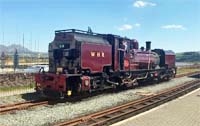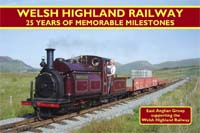
Welsh Highland Railway Society
Welsh Highland Heritage Railway
Welsh Highland Railway Heritage Group
Welsh Highland Railway Scenes - Several trips on the Welsh Highland Railway between Caernarfon and Porthmadog are recorded for this 18 minute video. The video was made shortly after the COVID lockdown of 2021 with assigned seating following social distancing guidance endorsed by the government. Also included was an unusual special train hauled by double-headed Fairlies "David Lloyd George" and "Merddin Emrys" along the route near Beddgelert - 2021.
Peter Johnson.
2018
Pen and Sword Transport.
Hardcover.
288 pages, 8.7 x 11.1 inches, $37.55 (Amazon)
The revival and restoration of the Welsh Highland Railway is one of the greatest heritage railway achievements of the 21st Century, yet its success followed more than one hundred years of failure. Supported by public loans, its first incarnation combined the moribund North Wales Narrow Gauge Railways, some of the abandoned works of the Porthmadog Beddgelert & South Snowdon Railway, and part of the horse worked Croesor Tramway. Opened in 1923, it was closed in 1937 and the track was lifted in 1941. Serious talk of revival started in the 1960s but restoration did not start until 1997, with the neighbouring Ffestiniog Railway at the helm, supported by generous donors and benefactors, the Millennium Commission, the Welsh Government, and teams of enthusiastic volunteers. Author Peter Johnson steers a course through the railway's complicated pre-history before describing the events, including a court hearing, three public inquiries, and a great deal of controversy, leading to the start of services between Caernarfon and Porthmadog in 2011. A postscript describes post-completion developments.
Author unknown.
2021
Mainline & Maritime.
Paperback.
64 pages, 9.11 x 6.07 inches, $14.95 (Amazon)
The rebuilding by the Ffestiniog Railway of the Welsh Highland Railway, Rheilffordd Eryri, a narrow gauge line through the heart of the Snowdonia National Park, was one of the most controversial of the millennium projects. In this paperback illustrated album, compiled by the East Anglian Group supporting the Welsh Highland Railway from the photographs and memories of their members, the changes and memorable events (both positive and negative) that have occurred on the WHR between 1994 and 2019 are shown.
Only two books on the Welsh Highland Railway are shown here but a search of Amazon Books found 18 other titles about the railway.

I have a few corrections and comments about the Welsh Highland Railway story:
1. The first three George England locomotives to arrive were "Mountaineer", "The Prince", and "The Princess" in 1863. "Palmerston" arrived the following year in 1864.
2. The sentence: "The Fairlies incorporation is but one of many things making the Ffestiniog Railway unique" isn't quite true - Fairlie locomotives ran on several railways around the world, not least Canada's Toronto Grey & Bruce Railway and the Toronto & Nipissing Railway. The Ffestiniog Railway wasn't even the first railway in Wales to use a Fairlie locomotive.
3. "1956, when steam service by Fairlie "Livingston Thompson" returned." - not true, steam service was initially provided in 1955 by the George England loco "Prince" (the name had changed from "The Prince").
4. "Slate was no longer the company's main source of revenue. Passenger fares on this intrepid line now contributed to company coffers" - is misleading. After 1955's revival slate wasn't just no longer the main source of revenue - there was *no* slate revenue from then on. Further, Passenger revenues were a substantial income for the company from 1865 onwards.
Dan Crow - 1 Nov 2009.




